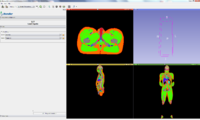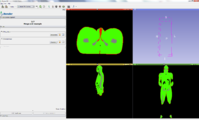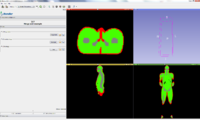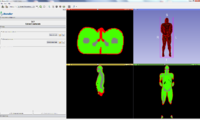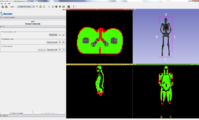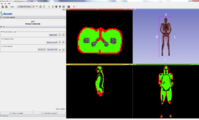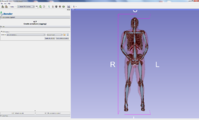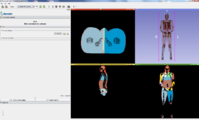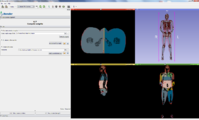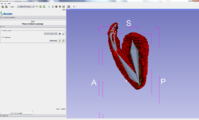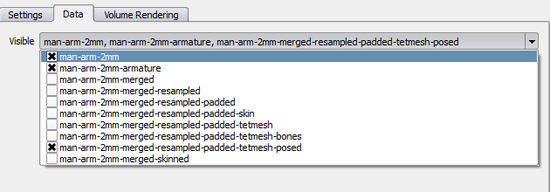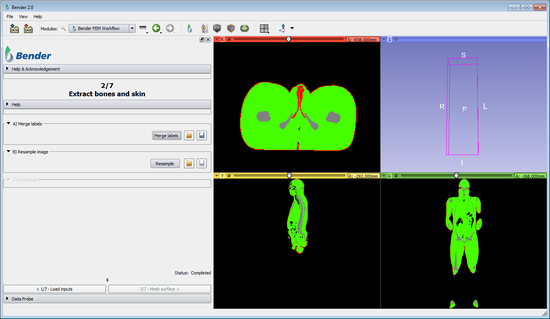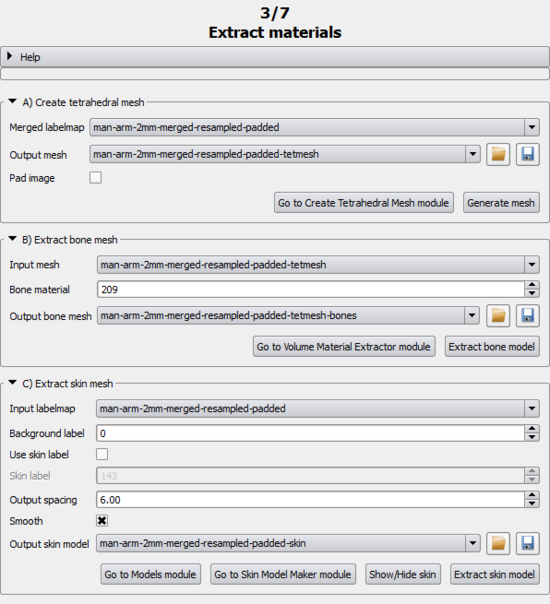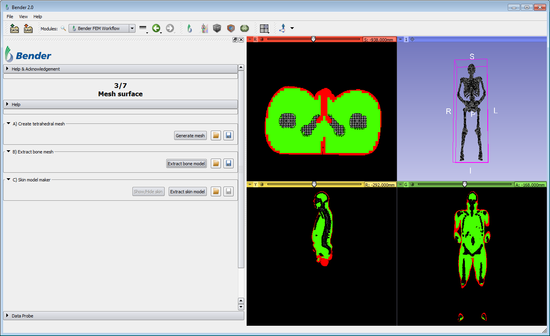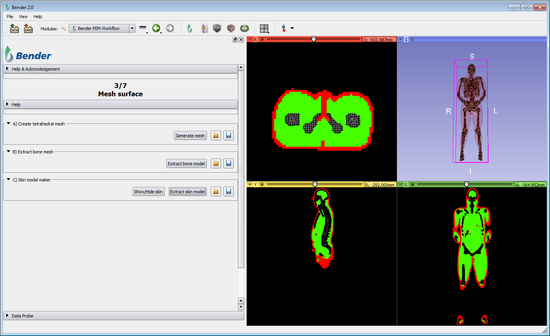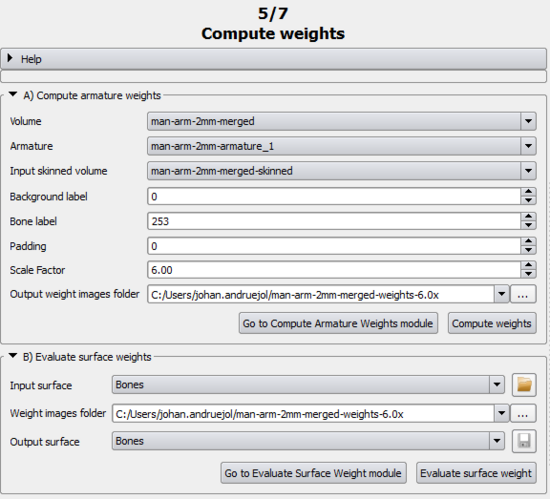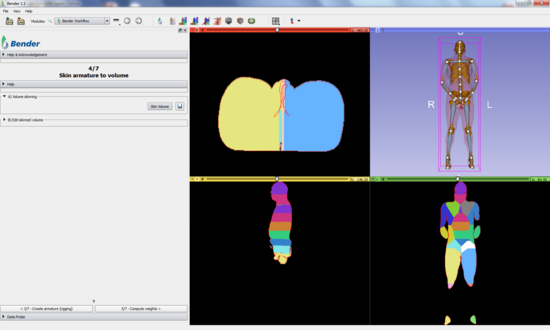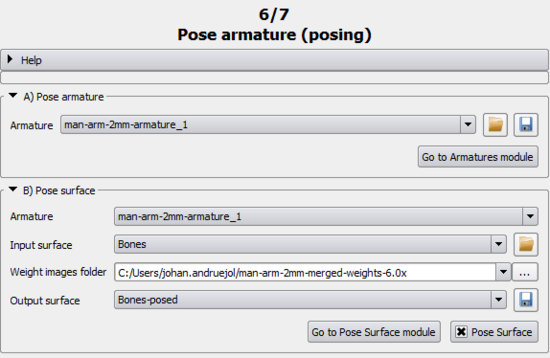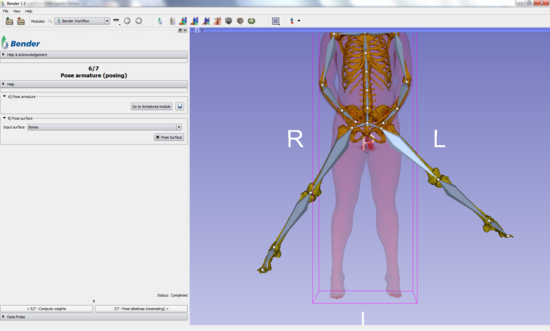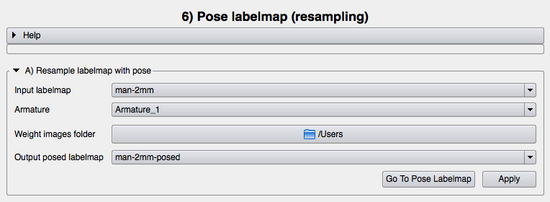|
|
| Line 230: |
Line 230: |
|
| |
|
| | valign="top"| | | | valign="top"| |
| [[Image:RigArmaturePanel-1.0.png|thumb|550px|Rig armature panel]][[Image:BenderWorkflow-v1.1-3-Armatures.png|thumb|550px|3-A)Armatures]]
| | [Image:BenderFEMWorkflow-v2.0-4-Armatures.png|[[# |4) Armature/Rig]][[Image:BenderWorkflow-v1.1-3-Armatures.png|thumb|550px|3-A)Armatures]] |
| |} | | |} |
|
| |
|
Revision as of 21:30, 21 March 2014
Introduction
The Workflow module guides the user step-by-step into transforming a volume using a rigging, skinning and posing technique using a multimaterial tetrahedral mesh and Finite Element Method (FEM).
Typically, the anatomical pose of a voxelized model is limited by the imaging device used to acquire the underlying data, e.g., MRI and CT scanners have narrow entries. Changing the pose of an already acquired voxelized anatomical model enables new processing of human anatomy in a wide variety of poses. The workflow module allows an operator to specify a rigging that represents the anatomical pose of an existing voxel model, manipulate that rigging into a different anatomical pose, and then generate a new voxelized model that represents the original model resampled into that new position.
This module applies to voxelized models the Skeletal animation technique initially conceived for surfaces.
Details
Author: Julien Finet, Kitware
Contributor #1: Johan Andruejol, Kitware
Acknowledgements: This work is supported by the Air Force Research Laboratories.
Contact: Julien Finet
Use Cases
Tutorials
Parameters
Advanced properties
The Advanced properties can be shown or hidden by clicking on the
Error creating thumbnail: Unable to save thumbnail to destination
expanding button.
Settings
- Workflow mode: Show/Hide advanced controls at each step of the workflow. There are 3 modes
- Basic: Most of the parameters are hidden, it provides a very simple step by step workflow.
- Intermediate: The main parameters are visible, the advanced options are hidden. In this mode, it is possible to go to the next step even without finishing the current step. It can be useful when starting a workflow not from scratch.
- Advanced: Full control is given to the user, almost all the parameters are shown. The full list of parameters is available in the specific module panels that can be opened by clicking the "Go to XYZ" buttons.
- Reload module: If the module script is edited, clicking the button reloads the script. It can be used to tweak the behavior of the module.
|
|
Data
- Visible: Check/Uncheck the data (Volume or Surface model) to show/hide in the 2D and/or 3D views.
|
|
Volume Rendering
|
The Volume Rendering section can volume render intermediate or final volume/labelmap.
- Labelmap: Select the volume/labelmap you want to volume render. The checkbox next to labelmap controls whether the rendering is visible or not.
- Label(s): List all the label(s) that should be visible (i.e. opacity > 0.), all the other labels will be hidden (i.e. opacity = 0.). Labels must be separated with a ',' (comma).
- Crop: Show/Hide a cropping box to apply to the volume rendering. Any voxel outside the box will be hidden.
- Go To Volume Rendering: Opens the Volume Rendering module. It gives full control over the volume rendering parameters such as the color and opacity transfer functions, shading, rendering quality...
|
|
1) Adjust labelmap
The Adjust labelmap is the first step of the workflow. The user selects here the volume to pose and can optionally prepare the volume before any further computation is applied.
A) Labelmap
This section makes sure the input labelmap has the right color table associated with it and is in the right coordinate system.
Simple options
- Volume: Select the volume/labelmap that you want to reposition. Read here the instructions to load data into Bender. The choosen volume will be automatically set as the default volume for all the following steps.
- Colors: Select the color transfer function to apply to the volume. It is assigned to the volume automatically once selected. For each voxel intensity, a unique color is associated and is used at display time. It is important to select the right transfer function of the volume because the color names in the color transfer function are used in the Merge labels section. Grayscale means the volume is not a labelmap and there is no color transfer function associated to it.
Advanced options
- Go to Volumes module: Go to the Volumes module to read volume information (such as its size, origin, spacing, scalar type, range...) and display properties (window/level, threshold, interpolation...)
- Go to Label Statistics module: Go to the Label Statistics module to compute statistics for each label of the loaded labelmap.
- LPS <-> RAS: Apply a (-1,-1, 1) transform to the volume. It can be used to apply the same coordinate system used by Bender to the volume. The "R,L,A,P,S,I" letters on the purple box in the 3D view represent the orientations "Right, Left, Anterior, Posterior, Superior, Inferior". Other transforms are available as well when opening the button's menu:
- Posterior <-> Anterior flips the image around the posterior anterior plane.
- Superior <-> Inferior flips the image around the superior/inferior plane.
- Center translates the image to the origin.
|
Error creating thumbnail: Unable to save thumbnail to destination |
2) Merge and resample
The 2) Extract bone and skin page creates the bone and skin surface models to interactively control the posing.
A) Merge labels
Some labelmaps can have multiple labels for representing bones (e.g. bone marrow, bone cancellous, skull...). This section provides the functionality of merging the bones labels and the skin labels of the input labelmap to simplify the visualization and usability of the bones and the skin.
It is important to merge those similar labels into a unique label (1 for the bones, 1 for the skin) as the Bender workflow handles only 1 label for the bones and 1 label for the skin. .
Simple options
- Output Labelmap: Select the output labelmap that will contain all the labels of the input labelmap and the merged labels.
- Merge Labels: Merge all the Input Labelmap labels into their corresponding labels given by the table.
Advanced options
- Input Labelmap: Select the input labelmap that needs labels to be merged together. By default, it is Volume in A) Labelmap.
- The table: The table lists all the labels that will be merged in one of the label categories. The different possible label categories are listed on the left side of the table. These labels corresponds from top to bottom to:
- Background
- Bone
- Muscle
- Skin
One the right side of each of those labels is listed all the labels that will be changed into one of them. These labels are automatically selected from the input volume color table (set in A) Labelmap) by looking for color names containing the strings corresponding strings.
- Go To Change Label: Open the Change Label module to merge other labels together or simply change label values.
B) Resample image
This section resamples the input merged labelmap using the Voting Resample module. This allow the mesh computation in Create Tetrahedral Mesh to be faster and lighter. The Voting Resample module is used here to make that the Bone and Skin and Muscle are not resampled in place of the background.
Simple options
- Output labelmap: Select the output labelmap under which the resampled image will be stored.
- Scale factor: Precise here the scale factor by which the Input Labelmap will be resampled down. The higher the factor is, the faster subsequent computation on the mesh will be. However this implies a loss of details which can lead to a mesh poorly representing the original data.
- Resample: Using a voting scheme and the High and Low precedence labels, downsample the Input labelmap.
Advanced options
- Input labelmap: Select the labelmap to resample from.
- High precedence labels: When downsampling an image, the algorithm must choose between labels to pick from for the new image. High precendence labels are always picked over the other labels. Order matters here as the first High precendence label is the label with the most precedence. In the workflow case, the precedence order is always Skin, Bone and Muscle. This allows us to make sure that the resampling does not change any of the image data to background.
- Low precedence labels: Much like the High precendence labels, Low precendence labels help to decide what label is picked over which when resampling. Low precendence labels are never picked over the other labels. Order matters here as the first Low precendence label is the label with the least precedence. In the workflow case, the background is used.
- Go To Voting Resample: Open the Voting Resample module to access more controls over the resampling.
C) Pad Image
This section simply pads the resample image of a few voxels to prepare it for the mesh generation using the Pad Image module.
Simple options
- Output labelmap: Select the output for padded labelmap.
- Pad thickness: Select the number of voxels of padding added around the Input labelmap. Two voxels is enough for the Create Tetrahedral Mesh module. More voxels can slow down the computation.
- Pad: Add extra padding voxels around the Input labelmap.
Advanced workflow
- Input labelmap: Select the labelmap volume to add voxels to.
- Pad value: Set the value of the voxels added to the Input labelmap. In this case, the value added is the background label.
- Go To Pad Image Module: Open the Pad Image module.
|
Error creating thumbnail: Unable to save thumbnail to destination Extract bone and skin panel 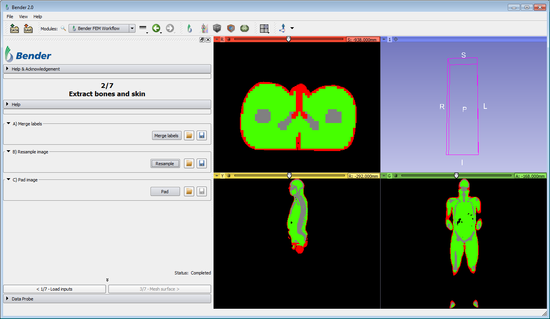 2-B) and 2-C)Resample image and Pad image |
3) Mesh surface
The 3) Mesh page generates a multimaterial tetrahedral mesh from the image and extracts bone and skin surface models to interactively control the posing.
A) Create tetrahedral mesh
In a FEM workflow, repositioning happens on a tetrahedral mesh instead of a labelmap volume. This section generates tetrahedrals with associated material for each voxel.
Simple options
- Output Mesh: Select the output that will contain the tetrahedral mesh.
Advanced options
- Merged Labelmap: Select the input labelmap that contains a limited number of materials (up to 3). By default, it is Output labelmap in 2.C) Pad image.
- Pad image: If non zero labels are at the border of the image, pad the image for correct results. This option is not required if the image has previously been padded in 2.C) Pad image.
- Go To Create Tetrahedral Mesh module: Open the Create Tetrahedral Mesh module to generate the tetrahedral mesh.
This section extracts the bone material from the input tetrahedral mesh.
Simple options
- Output bone mesh: Select the output mesh where the result mesh will be stored.
- Extract bone model: Generate the bone model using the Volume Material Extractor module. The extracted bone mesh is used when placing or adjusting the armature by ensuring the armature bones are on top of the labelmap bones.
Advanced options
- Input mesh: Select the tetrahedral mesh to extract the bone label from.
- Bone material: Select the label in the input mesh to create the bone mesh from. By default, it is the Bone Label value in Merge labels.
- Go To Volume Material Extractor module: Open the Volume Material Extractor module to access more controls over the model extraction parameters.
This section extracts the surface of the skin label in the input labelmap volume. The algorithm is different than Extract bone mesh because it solely needs the information of the background label. It creates an outer surface of the Foreground labels (all the labels that are not "Background").
Simple options
- Output skin model: Select the output model for the skin model.
- Show/Hide skin: Toggle the visibility of the generated model in Output skin model.
- Extract skin mesh: Using the Grayscale Model Maker, extract the outer surface of the Input Labelmap. The skin surface is used to enable collision when reposing the entire tetrahedral mesh in 7) Pose Armature(posing).
Advanced options
- Input labelmap: Select the labelmap volume to extract the skin model from.
- Background label: Select the threshold used to differentiate the body in the labelmap (foreground) from the outside air (background). Default is 0.
- Use skin label: Peel the skin in the output model, this generates an eroded skin model.
- Go To Models: Open the Models module to change the created model properties such as name, opacity, color...
- Go To Skin Model Maker: Open the Skin Model Maker module to access more controls over the model extraction parameters such as smoothing.
|
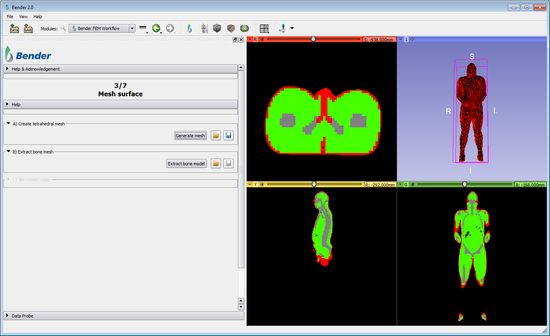 3-A)Create tetrahedral mesh |
3) Create armature (rigging)
This section creates the rig of the volume to pose.
Note: When opening this page, the view will automatically switch to 3D Only to help creating/visualizing the armature.
A) Armatures
Manually create or load an existing armature to fit on the bones of the volume to pose. The user is redirected to the Armatures module for manually editing (e.g. create/edit/remove a bone segment).
The armature (either created or loaded) is the interface between the user and the transformations needed to pose the volume models.
Note: Once completed, the armature rest positions should not be changed since it would require all the following computations to be updated as well. It is therefore highly encouraged to save the created armature in order to be able to restore it with Load armature from model.
Simple workflow
- Select a Preset: Choose a preset armature to load in the workflow. The preset armature are the same available than in the Armatures module. Which armature to load can be chosen by expanding the button's menu. This also allows to open directly an armature from file by clicking the option Load armature from file.
- Toggle Skin visibility: Same as Toggle Skin Visibility in Skin model maker. When dropping bones, bones are placed in 3D where the user click (X,Y) and at the depth (Z) of the closest surface model under the mouse cursor. It is advised to hide skin model when placing armature bones because you want them on the bones surface and not the skin surface .
- Load armature from model: Open a dialog window to load an armature from a model file. See Armatures module for further details.
- Go To Armature Module: Open the Armatures module to manually edit the armature by adding, moving, deleting bones in Rest mode. Armature display properties such as X-Ray mode, opacity, color or shape can also be modified.
|
[Image:BenderFEMWorkflow-v2.0-4-Armatures.png|4) Armature/Rig
|
4) Volume skinning
Before computing the weights, the skinning volume must first be extracted. The skinning volume represents what bone influence the most a given voxel. For each voxel a unique bone index is assigned.
This means that if we were to use binary weights (see Compute Armature Weight) , a given voxel would rotate similarly to its associated bone in the skinned volume. Because the skinning might not produces perfect results (some voxels might be assigned the wrong bones), and because the skinned volume drives the weight computation, it can be useful to tweak the output skinned volume, most notably in joints area. The Editor module can be used to edit the labelmap.
Note: When opening this page, the view switches to Four Up.
A) Volume skinning
Simple workflow
- Skin volume: Compute the skinned volume. The output skinned volume is a labelmap where each voxel of the input Volume is associated with a bone of the input Armature (voronoi style algorithm).
Advanced workflow
- Volume: Select the labelmap volume to use for skinning.
- Armature: Select the armature to skin Volume.
- Output skinned volume: Select the volume that will contain the output skinned volume.
- Go To Volume Skinning Module: Open the Volume Skinning module for advanced properties.
B) Edit volume skinning
Simple workflow
Advanced workflow
- Skinned volume: Select the volume that will be modified in the editor. More information in the Editor module documentation.
|
|
4) Compute weights
The Compute weights section assigns a weight for each voxel of the input volume. The weights represent how much a voxel is influenced by a bone. It is later used when posing the volume and computing the unique transform to apply at a voxel (by interpolating the influencing bones transforms).
A) Compute armature weight
Smooth the Skinned volume by computing weights in order to consider the influence of every bone on a given voxel.
Simple workflow
- Output weight image folder: Select the folder where the weight images will be saved. You need to have user write access.
- Compute weights: Compute the weight images. For each bone of the Armature, a weight image is created. A weight image stores by how much a given voxel of the Volume will be influenced when the associated bone moves. This computation is done by solving a heat-diffusion equation in which the bones of the volume represent the hot source. To increase computation speed, the input images are first downsampled by a scale factor. The resulting weight image is then upsampled back to the original image spacing.
Advanced workflow
- Volume: Select the volume that will be used for weight computation. It should be the same as in A) Volume Skinning.
- Armature: Select the armature associated with Volume. It should be the same as in A) Volume Skinning.
- Input skinned volume: Select the skinned volume to use for its bone regions. It should be the (possibly edited) volume associated with the Volume and the Armature generated in A) Volume Skinning.
- Background label: Treat the given pixel value as backgroung. It will not be part of the weight computation.
- Bone label: The bone label represents all the points of the labelmap which movement completely depend on one and only one bone of the armature. In the weights image, these points will either have the value 1 or 0 depending on their distance to the closest armature bone. In an anatomical study, this label should correspond to the bones of the patient. By default, the value is the same as the value used to extract the bones surface.
- Padding: Defines how far (in voxel units) outside the body the weight region will be computed. This can be useful in certain case where one wants to pose a surface that doesn't exactly lies on the body (for example, the skin obtained with a simple grayscale Model Maker). However, padding can cause issue around joints (most notably the armpits) and isn't necessary when posing a labelmap.
- Scale factor: The scale factor is used to speed up the processing. The weights are computated on downsampled version of the input labelmap according to this factor. These images are then up-sampled back to make sure they match the input image well. With a big scale factor, the computation will be faster but the weight images will be coarser.
- Go To Compute Armature Weights module: Open the Compute Armature Weight module to further refine the computation of the weights by, for example, restricting it to a given bone or changing the downsampling ratio.
B) Evaluate surface weight
To speed up Pose surface, weights at each vertices can be pre-computed.
Simple workflow
- Output surface: Select the output surface that will contain the evaluated weights at each point of Input surface.
- Evaluate surface weight: For each point of the Input Surface, evaluate the influence (weight) of each bone and add the weights into field arrays (one point data array per bone). This improves the computational time of the Pose Surface.
Advanced workflow
- Input surface: Select the input surface that will have the weight evaluated on.
- Weight images folder: Select the folder containing the weight image files.
- Go To Evaluate Surface Weight module: Open the Evaluate Weight module to access further parameters.
|
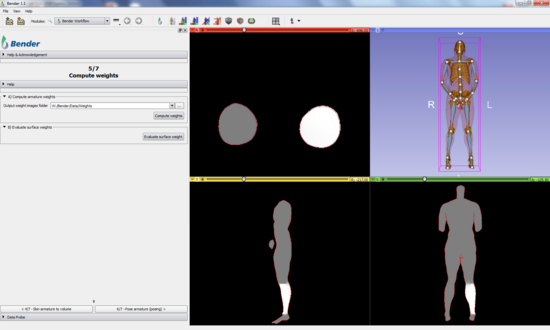 5-B)Compute armature weights |
5) Pose armature (posing)
The Pose armature section guides the user into posing the armature for the final Pose labelmap resampling.
Note: When opening this page, the current armature automatically switches to Pose mode.
A) Armatures
Pose the armature by applying rotations to armature bones. You can directly pose the armature from the 3D view, if needed the Armatures module can provide more controls.
Note: At this point only the Pose of the armature can be edited, if the "Rest" mode of the armature is changed, the skinned volume and bone weights must be recomputed.
Simple workflow
- Go Armature module: Open the Armatures module to further control the armature and its posing (e.g. reset the current pose to its originals rest value).
B) Pose surface
Transform a surface model according to the armature pose. Posing the skin (or bone) surface model gives a fairly good idea of what the result of the 6) Pose labelmap will look like.
Simple workflow
- Output surface: Select the output surface that will store the posed Input Surface.
- Pose surface: Pose the Input Surface according to the posed Armature and the weight images from the given Weight images folder. If the surface was first evaluated in A) Evaluate Surface Weight, this automatically uses the evaluated weights to compute the posed surface. Otherwise it reads the weights from the Weight images folder to compute the point weights (slower computation). If the checkbox is toggled, the module will automatically run anytime any input parameter is modified. If unchecked, the module run only once. Posing the skin surface and/or the bone surface is a way to assess the quality of the weights as well as to fine tune the pose interactively. Once the armature is posed and the surface looks fine, the pose can then be applied to the labelmap (longer process).
Advanced workflow
- Armature: Select the posed input armature.
- Input surface: Select the input surface to transform with the armature pose.
- Weight images folder: Select the folder where the weight image files are.
- Go To Pose Surface module: Open the Pose Surface module to choose the weight blending mode or decide whether to use the evaluated weights or not.
|
|
6) Pose labelmap
The 6) Pose labelmap section is the final step of the workflow, it uses the posed armature and the weights associated with the volume to compute the posed labelmap.
A) Resample labelmap with pose
Pose a labelmap volume given an armature and its weights.
Simple workflow
- Output posed labeldmap: Select the output labelmap that will store the transformed Input labelmap.
- Apply: Pose the Input labelmap according to the posed Armature and the weight images from the given Weight images folder. As this step may take quite some time in fine resolution (i.e. 1mm or 2mm), it is highly encouraged to first try to pose the bone surface model first to make sure that the pose does not create any anatomical error. The skin surface model should also be posed to verify that there is no overlap (to make sure for example that the hand does not go through the thigh).
Advanced workflow
- Input labelmap: Select the input labelmap to pose.
- Armature: Select the posed input armature.
- Weight images folder: Select the folder where the weight image files are.
- Go To Pose Labelmap Module: Open the Pose Labelmap module to tweak some parameters such as the Maximum radius to speed up the computation.
|
 6-A)Resample labelmap with pose |
Similar Modules
- Used modules
- Bender modules: Armatures, Change Label, Compute Armature Weight, Model Quadric Clustering Decimation, Pose Surface, Pose Labelmap, Sample Data, Skin Model Maker, Volume Skinning
- Slicer modules: Grayscale Model Maker, Models, Model Maker, Volumes, Volume Rendering
Developer Information
This module is a Python script module that can be manually edited for custom behavior (even in the installed version of Bender).
